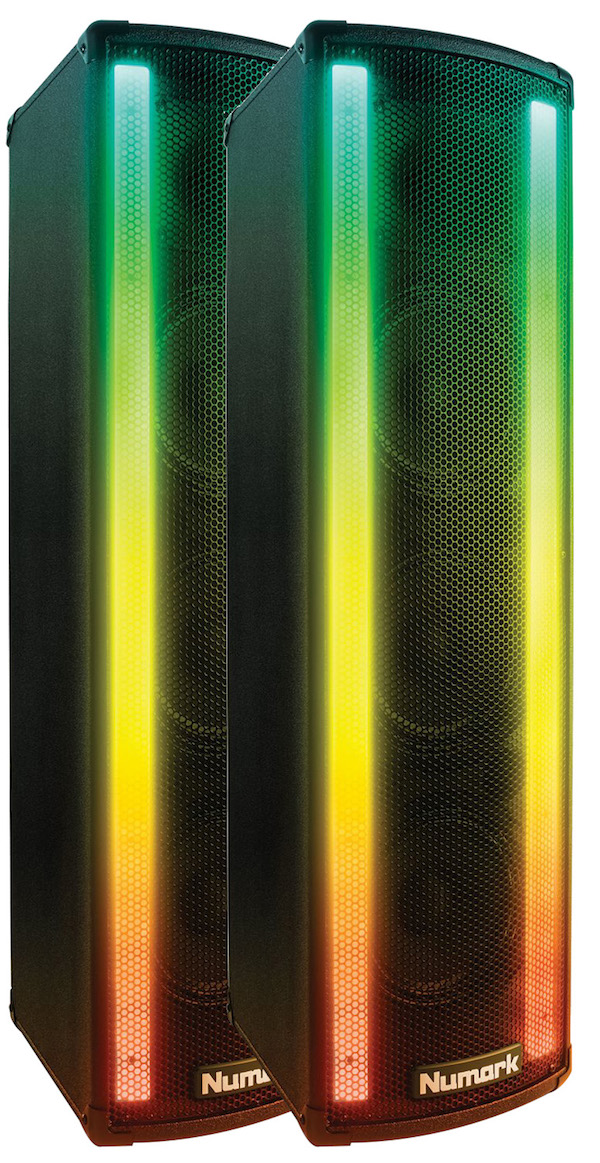The Lowdown
The Numark Lightwave powered speakers are unique in combining lights and audio into one unit, and they do a pretty good job of it – we ended up liking them far more than we thought we would.
Video Review
First Impressions / Setting up
They’re long and thin, which is quite a pleasing shape; you can see them slotting in nicely in small bedrooms, but also beside a DJ set-up without the need for stands (you can use them on stands, though).

They are sturdily built, with grilles and wooden cases and reinforced corners, so they feel ready for the road. They have a full array of speakers, cones and porting within them. A smart Numark logo finishes off the metal black grilles at the bottom. They have sturdy rubber feet.
Around the back are the power socket and on/off, and controls for attenuation of the line/mic combi XLR, master volume, lighting effect, light colour, and light brightness. A small LED shows you the light colour you have set, and another shows you that power is on. As well as the aforementioned combi XLR input, there are twin RCA ins, a useful 1/8″ stereo jack in (great for iPhone backup, for instance) and a mono XLR “link out”.
Assuming you’ve bought a pair of them, you could either plug your DJ controller in with two XLR cables (one to each speaker) for full stereo out, or plug in to the RCA (or even the jack) input on one speaker and link them together via the link socket on one and the combi XLR input on the other. This gives you ganged mono across both speakers from all three inputs. Note that there is no light sync; this is strictly audio. You’ll have to set how you want to lights to work individually from each speaker.
Finally, the only cables in the box are the power cable; you’ll need to supply all audio cables yourself.
In Use
Audio
The sound quality is pretty good. they’re not studio monitors, but they equally aren’t harsh like some PA speakers. You could certainly get away with using these at home as well as at parties. They are quoted at 200W, but that’s peak, not RMS; suffice to say they’re plenty loud enough for small venues and for home, although I’d recommend getting a subwoofer for a real low-end kick, something they lack a little of.
There is a bit of hum from them, but only the same as many speakers around this type of price; you certainly would never notice it at normal volume or above, although you might very late at night trying to keep as quiet as you can practising.
Lights
Of course, this is the big selling feature. There are a set of LEDs up the left and right of each speaker. You can set the brightness (turning it all the way down effectively turns them off), and then there are five modes:

- Mood – The lights light up solidly, turning the “color select” knob chooses which colour lights up
- Meter – The lights flash like VU meters to the music, again with the colour selectable via the “color select” knob
- Mix – The lights react to the music, changing colour on their own depending on the frequencies of the music
- Pulse – The lights flash to the music, but you choose the colour using the “color select” knob
- Party – The lights do their own thing regardless of the music, but you get to decide how intensely by turning the “color select” knob
In practice, they’re bright and certainly do the basic job. Some may find the VU meter-style setting a bit cheesy, but most will find a setting they like – even if it’s just locking them on a single colour to add a bit of atmosphere (great for late night sessions at home, for instance).
Conclusion
We thought these were a bit weird at first, but as soon as we set them up and started using them, we got to like them. They’re well made, and plenty loud enough for home and occasional party use. They are practical, having carry handles, holes for poles on the bottom, and a decent amount of protection for when you’re moving them around.
Bottom line is, you should never use home speakers for partying, and these solve that problem as you’re unlikely to damage them physically or electrically (due to their thermal cutouts) when playing at parties – and once you’re there, the lighting built in is a unique feature which we think lots of DJs will really like. For the price, they’re pretty good.




